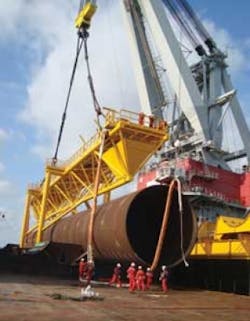Synthetic rope enhances deepwater development
Weight advantage increases with water depth
Dennis Sherman
Samson
The offshore industry is moving exploration and production into deep and ultra-deepwater. This presents challenges that do not exist in shallower waters. One example is subsea lifting and lowering. These traditionally are done with steel wire rope. Due to the high linear density of wire, it reaches a critical weight limit in deepwater and in most cases cannot be used efficiently, if at all. Lightweight synthetic lines are a solution with their high strength-to-weight ratio and the fact that they are weightless or nearly so in water.
For years synthetics have replaced steel wire strength members in some marine applications. In 1984, high modulus polyethylene (HMPE) rope replaced wire rope moorings on product tankers; and is now accepted in the shipping industry, making moorings easier and faster, and reducing mooring times by as much as two-thirds. The weight savings also have essentially eliminated handling injuries in key side-mooring applications.
Other applications where high-performance synthetics have supplanted wire are harbor towing lines in the tug industry, and wing and face wires in river barge applications.
However, this technology was not adopted overnight. Many tests and trials were performed to understand and prove the technology of synthetic ropes in comparison to steel wire.
While these applications prove of the advantages of synthetic rope over wire, the offshore industry seems reluctant to use synthetics in lowering and lifting lines and also heavy-lift slings.
Debunking misconceptions
There are a number of common misconceptions regarding the attributes and advantages of high-performance fiber ropes as steel wire replacements. The key misconceptions are examined below.
Strength, weight, and maintenance. One of the most common misconceptions is that synthetic rope is not as strong and reliable as steel wire. The fact is synthetic ropes made of high-performance fibers such as HMPE are size-for-size as strong as wire, at less than 15% of the weight.
This is the best argument for using synthetics. Weight savings translate into a number of advantages: the lifting equipment can be smaller; ropes are easier to handle; and the risk of bodily injuries is reduced. These lightweight lines enable operations to lift a heavier payload, and because they are neutrally boyant in seawater, they are a good choice for ultra-deepwater lifting and ROVs. In addition, synthetic ropes do not require relubing, which reduces maintenance costs.
UV stability. Another misconception is that the synthetic ropes have poor ultraviolet (UV) stability; i.e., they break down under sunlight. While this is true when compared with wire, if the fibers are treated with UV-resistant coatings, synthetic lines can be stabilized against UV damage.
Abrasion damage.Another thought is that synthetic ropes are susceptible to cutting and abrasion damage. Synthetic fibers are quite robust, however, and can withstand considerable abrasion. Furthermore, synthetic rope manufacturers can educate users in how much abrasion and cutting is acceptable and how to monitor and inspect for such damage.
Lifting applications
Many industry participants believe that synthetic ropes are less efficient than wire in static lifting applications. In fact, synthetics can be more efficient than wire in static lifting, depending onD/d ratios and loads.
D/d ratio. Rope manufacturers know that larger D/d ratios, where D is the diameter of the object the rope bends around, and d is the diameter of the rope, are friendlier to synthetics from a life expectancy standpoint in cycling applications. However, a winch with large diameter drums may not be practical where space and weight are considerations. A winch that is designed to handle loads in the range of 100 metric tons (~110 tons) at a 5:1 factor of safety (FOS) will have a synthetic rope with a minimum diameter of 88 mm (3.5 in.) if you follow wire rope rules.
A few rope manufacturers have invested in testing to understand the affect of smaller D/d ratios on rope service life, allowing them to educate operators about what they can expect if they choose smaller diameter ropes in order to capitalize on smaller winches.
Safety factors. Because of the perceived shortcomings of synthetic ropes in offshore applications, there is a discrepancy in the factors of safety between wire and synthetics. Certification bodies recommend use of various material factors to calculate and design a synthetic heavy-lift sling, for example.
Designers are advised to use a FOS as low as three for repeated lifts using wire. For synthetics, an FOS up to seven for engineered lifts is recommended. These recommendations tend to overcompensate on the FOS, unnecessarily increasing the diameter and strength of the rope. However, reports from companies using synthetics in heavy-lift slings are proving that the FOS can be lowered: After repeated heavy lift operations, upon inspection and residual strength testing, the slings are being recertified for continued use. If the slings had been designed and manufactured at a lower FOS, they could have safely accomplished the same job with a smaller diameter rope and saved the initial expense.
Cyclic bending
Cyclic bending over sheaves (CBOS) is no longer a problem for synthetics. Ten years ago select synthetic rope manufacturers, major oil companies, and winch OEMs came together to develop joint industry projects to understand and document the heat fatigue caused by CBOS. This failure mechanism often is seen in active heave-compensating winches used in E&P operations. As a result, products have been developed that retard the heat-failure mode in synthetics.
Synthetic slings made from Samson’s AmSteel-Blue allowed Seaway’s personnel to safely and quickly rig loads for offshore deployment.
One example of such a product uses the best characteristics of fibers, coatings, and other enabling technologies. HMPE has excellent bend-fatigue resistance and high strength. This, along with excellent abrasion and UV resistance, makes it a natural choice for lifting – except that it has poor heat resistance. However, research has determined that when HMPE is blended with poly(p-phenylene-2,6-benzobisoxazole), or PBO, expanded polytetrafluoroethylene (ePTFE), and specialized coatings, a rope that creates less frictional heat results. Used with monitoring systems to determine when the ropes reach their critical temperature, the affect of this failure mechanism is reduced. To date, this is the best and most widely tested and used option to overcome CBOS fatigue.
Manufacturers of aramid fibers have worked to improve their bending performance as well. Aramids are a natural fit for cycling applications since they have very high heat resistance. Although they traditionally perform poorly in cyclic bending applications, aramid fibers have been improved in recent years. Future testing will revolve around understanding the performance and failure mechanisms of these high-modulus, high-heat-resistant fibers as well.
Understanding synthetics
With multiple JIPs in progress to address these issues, the offshore oil and gas industry will come to a greater understanding of the failure mechanisms, efficiency rates, and inspection procedures associated with synthetic lines. This knowledge is paramount to designing lifts and winching operations that lead ultimately to accurate guidelines and standards for the design of synthetic rope solutions in deepwater lifting and lowering applications, as well as heavy-lift-sling applications.
The offshore industry recognizes that synthetic rope is the logical option for deep and ultra-deepwater and the increasingly heavier loads. The lessons learned from experience with steel wire are leading offshore engineers to understand synthetics, and their limitations.
Offshore Articles Archives
View Oil and Gas Articles on PennEnergy.com


